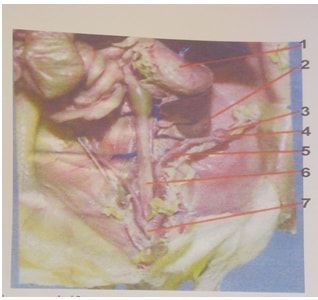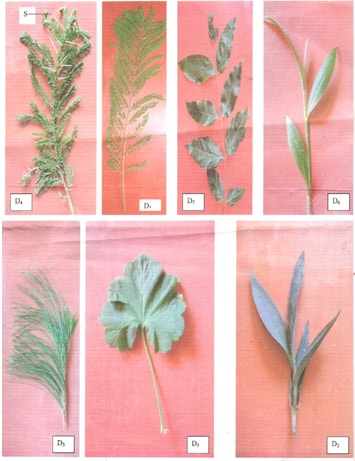- You are provided with solution W. Using the provided reagents; carry out possible food tests to identify food substances present in solution. (14mks)
Food substance
Procedure
Observation
Conclusion
- Examine the photograph which shows parts of the urogenital system of a female rat and answer the questions that follow. The organ marked 1 is the stomach.

-
- Name the organ marked 2 (1mk)
- State two functions of the organ (2mks)
- What is the functional unit of the organ in (a)(i) above (1mk)
-
- Identify and name each of the organs marked 3 and 4 (2mks)
- State two functions of the part marked 4 (2mks)
-
- Identify the organs marked 5 (2mks)
- Explain two functions of the organ named in c (i) above. (2mks)
- The organ marked 6 is the large intestine. State three function of the large intestine. (3mks)
-
- You are provided with seven specimens of plants. They are labeled D1, D2, D3, D4, D5, D6, and D7.
The dichotomous key
a) Leaves needle like ………………………………………………………………..go to 2
b) Leaves broad ………………………………………………………………….….. go to3
a) Leaves arranged in clusters on stem……………………………….………….. Pinnacea
b) Leaves not arranged in clusters on stem …………………………………….…..Araucariaceae
a) Leaves compound…………………………………………………..………….. go to 4
b) Leaves simple…………………………………………………….…………… go to 7
a) Leaflets pointed at the end …………………………………....……………….go to 5
b) Leaflets rounded at the end…………………………………….………………go to 6
a) Leaflets attached to many small stalks that join the main one ……………...….Mimosaceae
b) Leaflets attached to one stalk ………………………………….………………Rosaceae
a) Leaflets attached to many small stalks that join the main one……………...… Bignonaceae
b) Leaflets attached to one stalk ………………………………….………………Compositae
a) Leaves green ………………………………………………..………………….go to 8
b) Leaves purple ……………………………………………….……………….. go to 9
a) Leaves parallel veined ………………………………………..……..………..Graminae
b) Leaves net veined ………………………………………………….….……. Geranaceae
a) Leaves parallel veined ……………………………………………..……….…Commelinaceae
b) Leaves net veined ………………………………………………………..…….Euphorbiaceae
- Use the dichotomous key to identify the taxonomics group of each of the seven specimens in the photographs provided. (7mks)
Specimen Steps followed Identity
D1
D2
D3
D4
D5
D6
D7
-
- Suggest the possible habitat that specimen D4 is adapted to (1mk)
- Name one observable feature that adopts D4 to the habitat you have mentioned in (b) (i) above (1mk)
- Give a reason for your answer in (b) (i) above (1mk)
- State the importance of the structure labeled S in specimen D4 (1mk)
- Use the dichotomous key to identify the taxonomics group of each of the seven specimens in the photographs provided. (7mks)

MARKING SCHEME
-
Food substance
Procedure
Observation
Conclusion
Starch
To solution W add (2 drops of) iodine solution
Brown/ yellow colour persist/remains
Acc. No colour change observedStarch absent
Reducing sugars
To solution W add Benedict’s solution and heat/boil /warm
Colour /brown changes to blue to green to yellow to orange
Acc. Final colour.
Rej: red colourReducing sugars present
Ascorbic Acid
To DCPIP, add the food solution dropwise, while shaking.
Blue colorof the DCPIP rataines
Ascorbic Acid absent
proteins
To solution W add sodium hydroxide then copper (II) sulphate
Rej: heatBlue color of copper (II) sulphate retained
proteins absent
-
-
- Kidney;
- Osmoregulation;
- Excretion;
- Nephrone;
-
- 3-Funnel
4-Ovary - Site for production of ova/ female gametes/secondary oosytes;
Secretion of hormones ;
Uterus;
- 3-Funnel
-
- Site for implantation;
Nourishment and development of foetus; - Site for absorption of water;
Site for absorption of vitamins and mineral salts;
Propulsion of food down the alimentary canal;(any two points)
- Site for implantation;
-
- specimens steps followed identity
D1 lb,3a,4b,6a bignonagae
D2 lb,3b,7b,9a commelinaceae
D3 la,2a pinaceae
D4 lb,3a,4a,5a mimasaeeae
D5 lb,3b,7a,8b graminaceae
D6 lb,3b,7a,8a graminaceae
D7 lb,3a,4b,6b compositae -
- Semi-arid /dry/desert/arid (1mk)
- Small reduced needle-like leaves/presence of thorns/spikes (1mk)
- To conserve water/reduced transpiration rate/reduced water loss (1mk)
- Thorns/spikes provide protectors against injury by browsers/herbivores (1mk)
- specimens steps followed identity
Download BIOLOGY PAPER 3 - KCSE 2019 STAREHE PRE MOCK EXAMINATION (WITH MARKING SCHEME).
Tap Here to Download for 50/-
Get on WhatsApp for 50/-
Why download?
- ✔ To read offline at any time.
- ✔ To Print at your convenience
- ✔ Share Easily with Friends / Students

